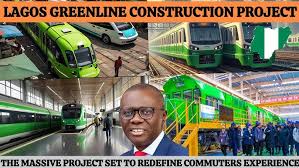Traffic congestion along the Lekki-Epe corridor has become one of the most pressing issues for Lagos residents and businesses, particularly affecting the Lekki-Epe Expressway, which stretches from Victoria Island to the Lekki Free Trade Zone.
EpeInsights reports that the rapid urban expansion of Lagos has outpaced the development of its transportation infrastructure, leading to longer commutes, traffic gridlocks, and a greater reliance on cars, exacerbated by frequent road repairs and limited public transport options.
To address this challenge, the Lagos State Government, through the Lagos Metropolitan Area Transport Authority (LAMATA), has initiated the Green Line project.
This $3 billion, 70-kilometre metro rail system is designed to alleviate the pressure on Lagos’ roads, specifically targeting the high-traffic Lekki-Epe corridor. Once complete, the Green Line will connect Marina to the Lekki Free Trade Zone, with 17 stations along the route.
The aim is to enhance urban mobility and connectivity for the growing population in the area, making it a vital link between the city center and the emerging economic zones of Lekki.

The Green Line will begin at Marina Station, following an elevated track that will pass major infrastructural landmarks, including the Five Cowries and Falomo bridges.
The line will then run parallel to the Lekki-Epe Expressway, with stations in high-demand areas such as Civic Centre, Lekki Phase 1, Freedom Way, Jakande Market, Chevron, and Ajah. After Ajah, the rail system transitions to ground level, passing through Abraham Adesanya, Sangotedo, Eleko, Ibeju, and finally reaching the Lekki Free Trade Zone.
Each station along the Green Line is designed to be fully accessible, featuring pedestrian bridges, elevators, and escalators. Supporting infrastructure includes a large 23.4-hectare depot in Sangotedo and a 15-hectare parking facility at the Free Trade Zone, making the system more accessible to a wide range of commuters.
The rail will operate with eight-car B-type trains running at speeds of up to 100 km/h, with a frequency of three-minute intervals, enabling the system to transport up to 35,000 passengers per hour in each direction.
Despite the promise of the Green Line in reducing road congestion, experts have raised concerns about several aspects of the project. One major issue is the station spacing, particularly on Victoria Island, which is only served by one station at Civic Centre.
Analysts argue that a more extensive network of stations in high-density areas like Bonny Camp, NNPC, and Union Bank along Ozumba Mbadiwe and Ahmadu Bello Way could alleviate congestion at individual terminals and improve accessibility for passengers.
The Lekki corridor, with its growing population, also presents a challenge. Current plans include a limited number of stations in the area, prompting recommendations to add more stops at high-traffic locations such as Sandfill, Maruwa, Graceland, Abijo, and Beechwood Estate.
Increasing the number of stations from 17 to 29 could boost the system’s passenger capacity from 340,000 to 580,000, although this would require an additional $240–$360 million and increase travel time by an estimated four minutes.
Another critique is the choice of eight-car B-size trains instead of the 10-car trains used on the Blue Line. Experts caution that this could limit the future capacity of the system, especially as demand increases along the densely populated Lekki corridor.
Cities such as Shanghai have faced similar issues, where initially underestimated capacities led to costly upgrades.
From a financial standpoint, the projected $3 billion budget for the Green Line equates to roughly $43 million per kilometre, which is notably high compared to global benchmarks for largely at-grade rail lines.
Given that 82% of the Green Line’s route is at-grade, international standards suggest that the cost could be lower, prompting calls for increased transparency and cost-effectiveness in the project’s execution.
A key recommendation from experts is that the Green Line should not terminate at Marina.
Instead, a seamless integration with the existing Blue Line would optimize operational efficiency and help mitigate congestion at the Marina terminal. This connection would allow passengers to travel uninterrupted from Lekki to other parts of Lagos, enhancing the overall usefulness of the system.
For the Green Line project to succeed, securing full funding before construction begins is essential. Lagos has often faced delays with its phased infrastructure approach, which can hinder timely delivery.
Building the entire line at once, as currently planned, would allow for faster completion and the creation of a more cohesive transport network, generating higher ridership levels from the outset.
Finally, rapid, well-coordinated construction efforts especially at night are necessary to minimize disruption during the project’s implementation. This would ensure that traffic congestion does not worsen while the rail system is being built, and that the Green Line can begin serving the public as soon as possible.












